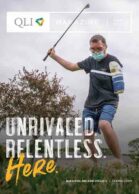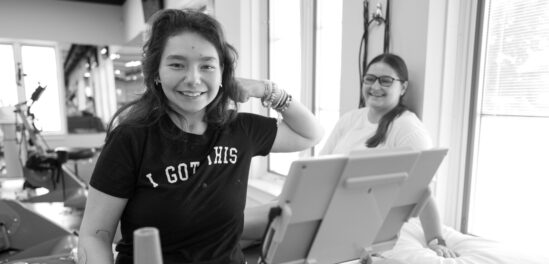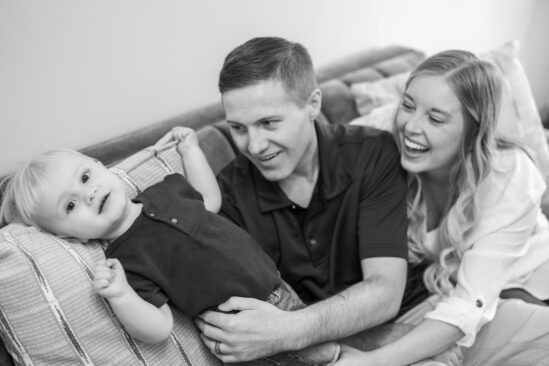 This year, we proudly welcomed Dr. Karen Hux as Director of Research to QLI’s ever-growing, ever-evolving rehabilitation and care continuum. Dr. Hux, a leading researcher in traumatic brain injury whose curriculum vitae includes countless academic publications and 27 years as a faculty member and professor at the University of Nebraska-Lincoln, brings to QLI a unique and knife-sharp perspective into the world of brain injury and language. We recently had the chance to sit down with Dr. Hux to learn about her path to QLI, her specialization as a researcher and academic, and her influence on our clinical services.
This year, we proudly welcomed Dr. Karen Hux as Director of Research to QLI’s ever-growing, ever-evolving rehabilitation and care continuum. Dr. Hux, a leading researcher in traumatic brain injury whose curriculum vitae includes countless academic publications and 27 years as a faculty member and professor at the University of Nebraska-Lincoln, brings to QLI a unique and knife-sharp perspective into the world of brain injury and language. We recently had the chance to sit down with Dr. Hux to learn about her path to QLI, her specialization as a researcher and academic, and her influence on our clinical services.
—
Tell us a little bit about your background.
I started out as a clinical speech-language pathologist in New Jersey after I’d finished my master’s degree. I was working in a free-standing acute rehab setting. This was back in the 1980s. That facility started a traumatic brain injury unit, and that’s when I knew this was the population I really needed to focus on.
Eventually, I decided I wanted to go back and get my PhD. My thought was that I would go to emphasize traumatic brain injury. I didn’t know a whole lot about PhD programs or how to pick a PhD program, so I went to Northwestern University because it was one of the top schools for speech-language pathology.
Northwestern didn’t have a person whose expertise was traumatic brain injury. Brain injury wasn’t big at this time. It was really a fringe area. I don’t think any place would’ve had a “traumatic brain injury expert” at this point. Of course, they had a person who specialized in aphasia and in child language. And they had speech-language pathology, audiology, and learning disabilities as one department with three divisions. That was a bit unusual. Usually, you didn’t have a learning disabilities department with that group.
The statistics professor who happened to be in that learning disabilities division was a cognitive psychologist by training. I would talk with him about all this stuff I was interested in related to cognition. I felt out of place in speech-language pathology. I didn’t quite fit there. I didn’t fit in with special education or learning disabilities. I was this real hybrid, not quite fitting anywhere. I ended up with two mentors—the psychologist, and then a child language expert.
The child language expert was the person willing to say, “Oh, you’re interested in how the brain works with language. Let’s do some readings together.” He was open to the idea of expanding beyond what he knew. He had an unusual philosophy toward language and child language. It was very linguistically based. He taught me all of that linguistic stuff.
When you mention “linguistics,” can you unpack that for us?
For us, it meant how the brain is pre-wired. How language is an innate process for children. Children only have to be exposed to a language in order to acquire it. Nobody has to teach them anything. They just have to hear it. As long as they are exposed, they will acquire language, unless there is some sort of brain damage. In that way, language isn’t behavioral in the sense that you have to teach children how to acquire language. It happens automatically.
I spent quite a bit of time with him studying how languages around the world differ from one another but all have this core at their basis, how everyone, when they’re born, starts with that core knowledge. We spent a lot of time doing that and then, related that to, what happens when there’s brain damage and language breaks down.

How did you get connected to QLI?
When I’d finished my PhD, the first job I found and applied for was at UNL. They were specifically advertising for a person in traumatic brain injury—which was unheard of at the time. I applied and loved the department, it was great, so I took that position.
When I got to UNL, it was the year QLI had opened. And I happened to meet Dr. Kim Hoogeveen at a meeting that was to write the definition of traumatic brain injury for the state. Brain injury had just been ruled as a disability category for special education. Kim, being the founding CEO of QLI—this new facility that was going to deal with brain injury survivors—and me, being the person who was going to deal with brain injury for the university, we were both asked to be on this committee writing this definition. So we met and just hit it off. Shortly after that, QLI started going around the country doing traumatic brain injury talks and I was part of that group. I was coming up here with students running single research projects. So, it was just a really—I was just lucky. I met the right people at the right time. Nobody else was coming to QLI to do research, so I was kind of welcomed with open arms.
I played by QLI’s rules—it was made very clear to me that we weren’t going to do research for the sake of doing research, we were going to do it to help the residents. That was the kind of research I liked doing, so it fit very well. It just kind of expanded from there.
When I felt it was time for me to move on from the university and find another place to be at, I assumed I would take another university position. At this point, I’d been a professor for years. I’d been very successful in terms of writing and research. I knew, pretty much, that I’d get my choice where I wanted to go.
After collaborating with QLI on research projects for so long, did you know QLI was actively pursuing more intensive research opportunities?
I had no idea. I’d asked [Dr. Jeff Snell] to let me know if there was anything at QLI for me, but I’d also made it clear I wasn’t looking for a straight clinical position. I was really interested in doing research. That’s when it was made clear to me that QLI was putting an emphasis on getting information about their program into the literature. It was the perfect fit.
How did you, or how do you currently, go about defining your role as a self-directed researcher for QLI? What are the projects that you’re able to speak about?
To start, I brought a research grant with me. I’m one of several researchers across the country on this grant right now. When a faculty member has a grant and they move from one situation to another—another university or organization or whatever—they take that grant with them. That is a three-year project that started a year ago. That has a series of five projects associated with it. Those will be the first five projects that I’m doing.
They’re related to aphasia, all related to supporting reading. We’re using assistive technology to support that, text-to-speech technology. Because of the type of grant it is, I operate as more of a consultant. I’m preparing all the stimuli and doing all the data analysis and the write-ups.
There are also some projects I brought with me from UNL that weren’t finished, sort of mid-stage. Some of those are still going on. I’m working on an eye-tracking study that I’ve been running individuals here for. That particular study has been going on for a long time. It looks at the effects of traumatic brain injury when people read paragraphs—what are their eyes doing as they’re doing that reading. What do they pay attention to when they’re reading.
There are others we work on, too. Sometimes projects come to me from the team here. One of our nursing team members had approached me for a project he’d wanted to do for his master’s degree, but hadn’t been allowed to do because his advisor told him it was too complicated. The advisor had kind of forced him to do this other project he wasn’t interested in. He brought it to me and it was apparent that this was a great idea. We started work right away on it. He was thrilled.
And one of the projects we’re working on now is more on the culture at QLI and how patients’ families as well as residents here have experienced culture.
How do you measure that?
It’s a study where we are asking people—a family member, for instance—to think back to the beginning of this process, when they first learned their family member was injured, continuing through all their time at the trauma center, acute rehab, and at QLI. I try to catch people as they leave here. Have them think of that whole process and think about the moments they’ll never forget, that stand out. Were there things that were said? Who said them? How did they made you feel?
Is that limited to their interactions with clinical staff?
It can be from anybody. What happened during this time? It could’ve been an ‘A-ha!’ moment—oh, this is what my future is going to be like. Or maybe it was a devastating moment. You know, I’m being told that my son or husband will be injured like this for the rest of their life. It can run the entire gamut. The goal is to get reports along that whole continuum, ideally to be able to talk about the importance of the environment and the things that are said and who says them to family members—the approach to recovery from injury. How do families and survivors perceive that, to the extent that they can tell me.
 Are you finding yourself being more involved with the clinical programs happening here, having hands-on opinions of those processes?
Are you finding yourself being more involved with the clinical programs happening here, having hands-on opinions of those processes?
Because I’m the researcher, I have the freedom to say, “I’d like to be involved in this case.” When a case comes in that’s interesting from the standpoint of an unusual diagnosis, or fits the criteria of someone I might need from a study, then I request to be included in team meetings, so I can sit in and get to know what’s going on with that person.
In recent cases, we’ve had residents come in with reading and writing deficits that were pretty massive. The goal is that they go back to where they were. I was fortunate—just a couple of years ago I’d completed a study on acquired reading problems. My doctoral student has spent the last two years looking at writing problems. So, it fits. I was able to join the rehab team and say, yeah, I know what to do.
So, I get involved clinically as much as it seems appropriate. If it turns into something that other people should know about, then I write it up
You mentioned earlier that QLI doesn’t do research for the sake of it, that it should be done for the benefit of the individuals we serve. It feels a little like that has come full circle for you. Do you feel like that is your ultimate goal as a researcher, to be a resource of information that will directly impact the treatment of traumatic brain injuries?
Absolutely.
There’s been a shift in recent years towards research that takes pictures of the brain—MRIs and photography. We can study the brain. We can do electroencephalographs. It’s all very interesting. But it doesn’t change how I’m going to treat that person tomorrow.
That kind research is very important, obviously, but it’s not the research that I like, and it’s not the kind that has an impact on what I’m going to do clinically the next day. Speech-language pathology is still a clinical profession. The vast majority of people who go into this practice are going to be face-to-face with people who have communication needs. We need information to say this works or this doesn’t work.
What do you feel makes QLI such a unique space for research?
There are facilities across the country that do rehabilitation after serious injuries. I’ve worked at some of those institutions.
I’ve never been in a work situation that has involved as much creativity, or as much individualization as what happens at QLI. Other organizations give lip-service to individualization and to working as a team. But I’ve worked on those teams. All that means is that you go to the same team meetings to present to the doctor. You’re not working together, necessarily.
There’s a lot more flexibility at QLI in terms of creating a program that fits an individual. That in and of itself is unique. Look at how Person A’s schedule differs from Person B’s and Person C’s. You don’t get that in acute rehab. There, you have OT, PT, Speech, lunch, followed by OT, PT, Speech. QLI has so many things that are specific to that person’s interests or needs. The amount of time a person is getting for specific needs goes way beyond what they get in a hospital or acute rehab setting.
That’s just one piece of what goes on here, one piece of what makes it different from an acute rehab facility. Or what a person might get if they just went from acute rehab back to home.
That’s really refreshing. That’s really special.












